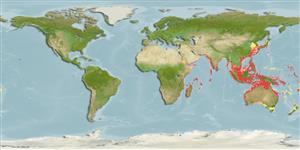Common names from other countries
>
Pleuronectiformes (Flatfishes) >
Soleidae (Soles)
Etymology: Aesopia: Term related to Latin fabulae; Quintilian recognized the existence of the Aesopia as "beast fable"..
More on author: Kaup.
Environment: milieu / climate zone / depth range / distribution range
Ecologia
marinhas associadas(os) a recifes; intervalo de profundidade 8 - 100 m (Ref. 9710). Tropical
Indo-West Pacific: Red Sea, Mozambique, South Africa, India and Japan. Reported from Indonesia and northwestern Australia (Ref. 5978).
Tamanho / Peso / Idade
Maturity: Lm ? range ? - ? cm
Max length : 25.0 cm SL macho/indeterminado; (Ref. 48637)
Descrição breve
Chaves de identificação | Morfologia | Morfometria
Espinhos dorsais (total) : 0; Raios dorsais moles (total) : 69 - 79; Espinhos anais: 0; Raios anais moles: 59 - 66; Vértebras: 46. Greyish or brown, with 15-16 dark bars edged with black (the first 3 bars on head); caudal fin blackish with pale spots (Ref. 3200).
Found in coastal waters (Ref. 30573), on sand or mud bottoms to at least 100 m (Ref. 9710, 11230, 48637).
Life cycle and mating behavior
Maturities | Reprodução | Spawnings | Egg(s) | Fecundities | Larvas
Heemstra, P.C. and O. Gon, 1986. Soleidae. p. 868-874. In M.M. Smith and P.C. Heemstra (eds.) Smiths' sea fishes. Springer-Verlag, Berlin. (Ref. 3200)
Categoria na Lista Vermelha da IUCN (Ref. 130435)
CITES (Ref. 128078)
Not Evaluated
Ameaça para o homem
Harmless
Utilização humana
Pescarias: espécies comerciais
Ferramentas
Relatórios especiais
Descarregue XML
Fontes da internet
Estimates based on models
Preferred temperature (Ref.
115969): 23.3 - 29.1, mean 28 (based on 1750 cells).
Phylogenetic diversity index (Ref.
82804): PD
50 = 1.0000 [Uniqueness, from 0.5 = low to 2.0 = high].
Bayesian length-weight: a=0.00977 (0.00473 - 0.02021), b=3.07 (2.90 - 3.24), in cm Total Length, based on LWR estimates for this (Sub)family-body shape (Ref.
93245).
Nível Trófico (Ref.
69278): 3.5 ±0.5 se; based on size and trophs of closest relatives
Resiliência (Ref.
120179): Médio, tempo mínimo de duplicação da população 1,4 - 4,4 anos (Preliminary K or Fecundity.).
Fishing Vulnerability (Ref.
59153): Low vulnerability (21 of 100).
